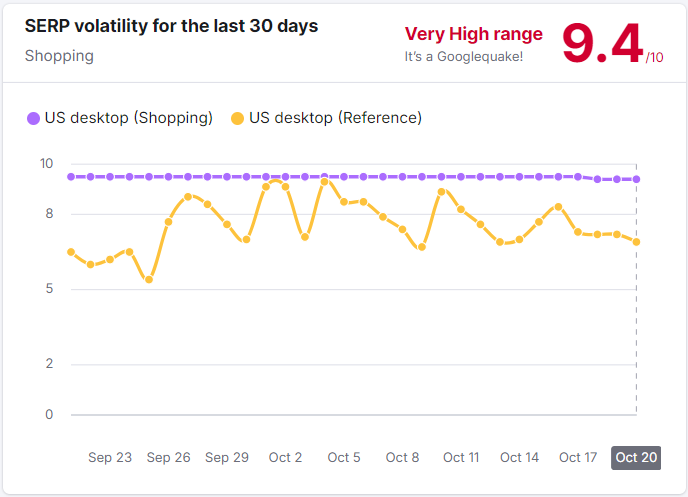Imagine you're in a race, sprinting toward the finish line, but the course changes midway.
One moment, you're on a smooth track; the next, you're hurdling over personalized search results, AI-generated briefs, and virtual try-ons—all while competitors, some of whom you've never even heard of, zoom past like they're on jetpacks. Welcome to the AI-powered world of Google Shopping, where algorithms rewrite the rules and even the biggest players must rethink their strategies.
Introduction
In the not-so-distant past, a retailer could count on a well-optimized Product Listing Page (PLP) to grab a prime spot on Google’s search results and watch the clicks roll in.
But today, thanks to Google’s AI-fueled shopping overhaul, those days are rapidly disappearing. With the Shopping Graph and Gemini models behind the wheel, product recommendations are now hyper-personalized, dynamic filters have become the new gatekeepers, and retailers—both big and small—are grappling with new ranking volatility. And if you’re one of the big names, congratulations, you’ve got a front-row seat to Google’s latest 'David vs. Goliath' experiment, where smaller, often unheard-of brands are suddenly getting a head start you never saw coming.

Above: Screenshot of Semrush’s Sensor data showing 30-day SERP volatility for Shopping vs. Reference websites.
This transformation doesn’t just make search faster and smarter for shoppers—it’s fundamentally changing the eCommerce battlefield. The question isn’t just how to compete, but how to adapt, optimize, and outsmart the AI that’s powering the system. In this guide, we’ll dive into what’s changed, why it matters, and most importantly, how retailers can avoid getting left in the algorithmic dust.
AI-Powered Shopping Transformation
While the SERP volatility chart above shows how retailers are grappling with instability, it’s clear that Google's AI-powered changes are shaking up eCommerce. But despite all the buzz—Shopping Graph, Gemini models, dynamic filters—the real question is, who exactly are these changes meant to help? Google claims it’s all about enhancing the user experience, but dig a little deeper, and it starts to feel like spaghetti being thrown at the wall, hoping something sticks.
Why? Because Google is playing catch-up in a game they’re not used to losing.
Google’s AI Capabilities: Shopping or Survival?
With over 50% of product searches now starting directly on Amazon, Google has found itself scrambling to maintain relevance in the shopping space. Enter the Shopping Graph and Gemini models—tools designed to enhance the shopping experience by tailoring search results to users’ needs. Want a men’s winter jacket in Seattle? Google serves up an AI-generated brief with recommendations that supposedly meet your needs.
But while these features may sound user-friendly, they also feel like a scattershot attempt to stay relevant.
But while Google’s Gemini models and Shopping Graph may sound like the future of retail search, beneath the surface is a scramble for survival in a world where over 50% of product searches now start directly on Amazon. Google’s AI-generated briefs may help tailor results, but they also reveal a deeper struggle to keep shoppers within its ecosystem—before Amazon claims them.
AI-Driven Personalization: Helpful or Distracting?
There’s no denying that AI has the power to personalize, but is this "personalization" what shoppers actually need—or is it just another way for Google to prolong user engagement? The new personalized home feed and virtual try-ons sound like they’re designed with the user in mind, but they also serve a deeper purpose: keeping users from bouncing over to Amazon.
Instead of finding what they need quickly, users are now greeted with endless options, curated feeds, and AI-generated product briefs. Sure, it’s cool that Google remembers the jacket you didn’t buy last week, but with all this personalization, are we really making the shopping experience more efficient—or just adding more distractions?
Impact on Search and Shopping: A Win for Users or Google?
For Google, the AI-powered updates have one goal: keep shoppers within their search bubble. But for retailers, especially large established brands, these updates are making an already volatile landscape even shakier. As fewer organic listings appear per SERP, and AI curates product results based on user data, larger retailers are finding it harder to stay visible.
While the relevance and accuracy of recommendations may be improving for users, the shrinking number of traditional organic placements means that established brands are seeing their hard-earned rankings replaced by AI-selected products.
Google’s new approach to shopping seems less like a thoughtful innovation and more like an experiment in keeping up with the likes of Amazon—and for retailers, the costs of falling behind could be steep.
Conclusion
As Google advances its AI-powered shopping tools, the strategies that once guaranteed visibility and sales are no longer reliable. Retailers who don’t adapt risk being left behind in an ever-changing landscape.
Whether it’s optimizing PDPs, improving local inventory feeds, or leveraging AI-generated content, retailers must rethink their strategies to thrive. In the battle between Google and Amazon, the retailers that innovate will come out on top—complacency is not an option.
If you’re unsure how to navigate these shifting dynamics or need expert guidance to stay ahead, Acadia is here to help. Our team can partner with you to develop the strategies that will keep your business competitive in this AI-driven landscape.
